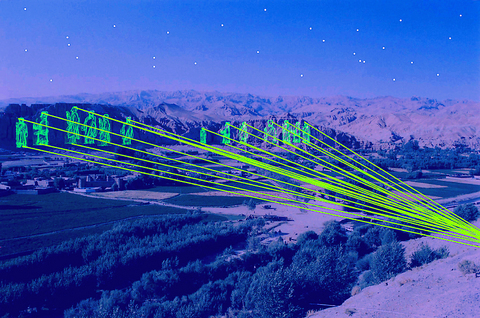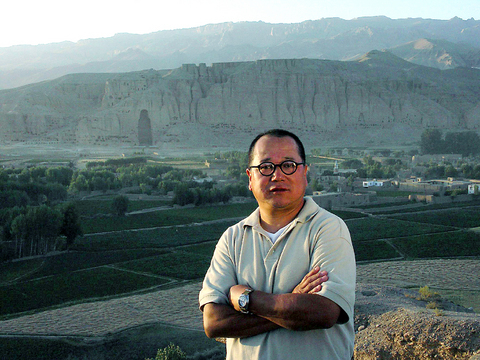Japanese artist Hiro Yamagata has announced plans to recreate Afghanistan's destroyed Bamiyan Buddhas using as many as 240 laser beam images, a giant project that could also bring electricity to local people.
The US$60 million exhibit, which is slated to begin in June 2007, will for several years replicate the images of the statues, which were the world's tallest standing Buddhas until the Taliban regime destroyed them.
"When I first visited Bamiyan, I was very impressed with the sights of valleys, as well as local children, local people," said the globally acclaimed artist, known for his large laser-beam art works.

PHOTOS: AFP
"Every time I go back, I feel the growing passion of wanting to create art there," he added.
Yamagata plans to show the images for two hours from sunset four days per week. He is still in negotiation with the Afghan government and local entities on how long the exhibition will last but it will likely be for years, he said.
The high-tech project to recreate the destroyed cultural assets could also be important for the local economy in one of the world's poorest countries.

To create the laser images, Yamagata plans to install 120 laser systems, 10 windmills and 11,988 solar energy panels.
Yamagata and the Afghan government anticipate the power generating systems would be able to supply about 100 watts for six hours daily to each household of the area which is still not being provided electricity.
Afghan ambassador to Japan, Haron Amin said the project could transform Bamiyan into a tourist destination. He called it an "eco-friendly, environment-friendly and energy-friendly concept."
The Islamic fundamentalist Taliban, ignoring world protests, dynamited the two 1,500-year-old statues carved into the sandstone cliffs of Bamiyan in March 2001, branding them un-Islamic.
The regime was ousted later that year in a US-led military campaign after the 9/11 attacks. In a parallel, the World Trade Center was represented by light rays in an artistic memorial after the twin towers were brought down by hijacked airplanes.
Afghan Minister of Information and Culture Sayeed Makhdum Rahin, attending a press conference in Tokyo with the artist, said the laser beams were an appropriate way to represent the destroyed statues.
"Three years ago when we had an international seminar on Afghanistan's cultural heritage, many people wanted to discuss reconstruction of Buddha statues ... I did not agree with the idea," Rahin said.
"Those statues belonged to a different generation, different time and different situation."
"I'd say let's keep the spaces the way they are. Let these spaces be witnesses for what human beings did to culture and history in the beginning of the 21st century," he said.
Yamagata said he would agree with the minister "even if I weren't an artist using lasers."
"We can't change the history of destruction, so I myself think it would be silly to build something new to replace them," he said.
He doubted governments would provide financial support. Instead, he plans to raise donations by throwing
charity parties and from non-governmental organizations and corporations.
He already has brought celebrities onto his project committee including Dennis Hopper, Sharon Stone and Canadian film director James Cameron.
Asked about security in Afghanistan, much of which is racked by violence by Taliban remnants, Afghan ambassador Amin called on foreigners to visit Bamiyan but warned them not to go through the Pakistani city of Quetta near the border.
Earlier this year two Japanese schoolteachers, reportedly on their way to Bamiyan, were shot dead on an Afghan highway linking Pakistan to the Taliban's former stronghold of Kandahar.

That US assistance was a model for Taiwan’s spectacular development success was early recognized by policymakers and analysts. In a report to the US Congress for the fiscal year 1962, former President John F. Kennedy noted Taiwan’s “rapid economic growth,” was “producing a substantial net gain in living.” Kennedy had a stake in Taiwan’s achievements and the US’ official development assistance (ODA) in general: In September 1961, his entreaty to make the 1960s a “decade of development,” and an accompanying proposal for dedicated legislation to this end, had been formalized by congressional passage of the Foreign Assistance Act. Two

March 31 to April 6 On May 13, 1950, National Taiwan University Hospital otolaryngologist Su You-peng (蘇友鵬) was summoned to the director’s office. He thought someone had complained about him practicing the violin at night, but when he entered the room, he knew something was terribly wrong. He saw several burly men who appeared to be government secret agents, and three other resident doctors: internist Hsu Chiang (許強), dermatologist Hu Pao-chen (胡寶珍) and ophthalmologist Hu Hsin-lin (胡鑫麟). They were handcuffed, herded onto two jeeps and taken to the Secrecy Bureau (保密局) for questioning. Su was still in his doctor’s robes at

Last week the Democratic Progressive Party (DPP) said that the budget cuts voted for by the China-aligned parties in the legislature, are intended to force the DPP to hike electricity rates. The public would then blame it for the rate hike. It’s fairly clear that the first part of that is correct. Slashing the budget of state-run Taiwan Power Co (Taipower, 台電) is a move intended to cause discontent with the DPP when electricity rates go up. Taipower’s debt, NT$422.9 billion (US$12.78 billion), is one of the numerous permanent crises created by the nation’s construction-industrial state and the developmentalist mentality it

Experts say that the devastating earthquake in Myanmar on Friday was likely the strongest to hit the country in decades, with disaster modeling suggesting thousands could be dead. Automatic assessments from the US Geological Survey (USGS) said the shallow 7.7-magnitude quake northwest of the central Myanmar city of Sagaing triggered a red alert for shaking-related fatalities and economic losses. “High casualties and extensive damage are probable and the disaster is likely widespread,” it said, locating the epicentre near the central Myanmar city of Mandalay, home to more than a million people. Myanmar’s ruling junta said on Saturday morning that the number killed had